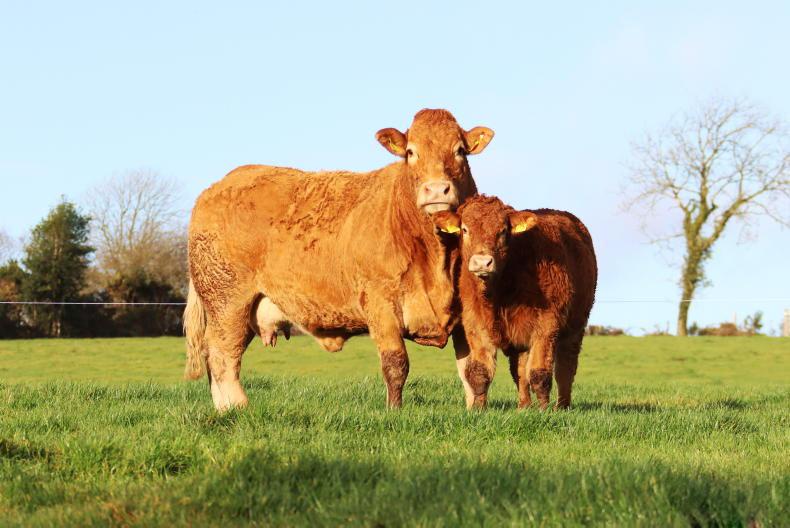Teagasc has predicted a further decline in suckler cow numbers up to 2027 as part of its outlook on what the beef sector will look like in 2027. It is also predicting a reduction in the number of farms with beef cattle. However, it does see an increase in the number of farms rearing and finishing calves from the dairy herd.
For these dairy calf-to-beef enterprises to be successful, Teagasc points to better integration of dairy farm and beef farm decision-making on genetics used on the dairy herd. This starts with dairy farmers using bulls of sufficient genetic merit for carcase weight and carcase confirmation.
Without the correct raw material, dairy-beef systems will be problematic for beef farmers. Teagasc says that environmental considerations including reducing net greenhouse gas emissions will be one of the key priorities for the beef industry over the coming years.
Research into clover swards will play a huge role in reducing chemical nitrogen application on drystock farms. Better genetics in the suckler herd will also increase carbon efficiency and reduce the carbon footprint.
In the calculation of all the models, Teagasc has used €3.75/kg for beef price, €160/head for bull calves and €130/head for heifer calves.
Table 1 refers to the current research performance in suckler beef systems in Teagasc research herds. This is what the industry could achieve if everything was technically efficient. On a 22-month steer system utilising 10.6t of grass/ha, production costs come in at €3.11/kg. Currently, the average suckler farm is utilising 6.2t DM/ha of grass, so a big improvement is needed on drystock farms if these figures are to be attained on commercial farms.
Table 2 refers to the current research performance in dairy calf-to-beef systems. Again, grass utilisation is very high at over 10t/DM/ha. Production costs in this system are €0.15/kg higher for dairy beef when calf cost is included.
Comment
Teagasc has pointed to a reduction in the slaughter age as a key driver in terms of financial progress and reducing the carbon footprint of beef.
However, bulls seem to have been forgotten about in this argument. To date in 2020, we have slaughtered 65,288 fewer young bulls compared to 2019.
Young bull beef production has proven to be one of the most carbon-efficient and profitable systems that Irish farmers can operate, yet the industry has turned its back on it.
The majority of these animals have been transferred into a steer system, meaning the industry will have upped the slaughter age from 15 or 16 months to 28 or 29 months, an increase of 12 to 14 months.
The fact that we have no data on “real farm” dairy calf-to-beef systems is a weakness of the roadmap publications.
With an increase in the number of farms operating dairy calf-to-beef enterprises, Teagasc needs to get a handle on actual farm performance within these systems to develop profitable systems.
Relying on research data that is operating way beyond what is actually happening on farms is difficult for farmers to relate to.
Part-time, low-stocked farms
With the majority of beef farms operated on a part-time basis, you have to ask yourself the question, is there an appetite on these farms to drive stocking rate to the limits of 2.6LU/ha in suckler systems and 3LU/ha in dairy calf-to-beef systems as is currently being operated on Teagasc research farms?
If a drystock farmer wanted to keep the stocking rate on their farm at 1.6LU/ha to 1.7LU/ha and operate at an efficient level across all other parameters, suckler beef systems slaughtering steers at 22 months and heifers at 19 months come out on top in terms of net margin per hectare.
Something Teagasc hasn’t factored into the analysis is if we compare both dairy beef and suckler beef systems on a support basis, there is a marked difference in the level paid to each sector.
Suckler cows are currently attracting close to €200/cow in supports through schemes such as BDGP and BEEP.
Table 3 outlines three beef production scenarios under a low stocking rate.
One of the most interesting aspects of this table are the beef production costs.
Suckler beef comes in at 0.30/kg less in terms of per-kilo production costs. This translates to a net margin of €274/ha, around €50/ha higher than the dairy-beef systems.
It is also a lower-risk system, with the sensitivity analysis at the bottom of the table showing the decrease in net margin as a result of a €0.10/kg reduction in beef price.
This beef production would mean a reduction of €32/ha in a suckler beef system and this reduction doubles to a €67/ha reduction in the dairy heifer beef system.
There seems to be a resignation by some that suckler cow numbers will continue to decline and that this will make way for dairy calf-to-beef production systems.
The Teagasc figures don’t back up this argument. Yes, at higher stocking rates, dairy calf-to-beef systems are more profitable, but with higher stocking rates comes the necessity of growing in excess of 10t DM/ha of grass.
We have seen from existing dairy calf-to-beef systems that high grassland utilisation is key to achieving a positive margin. We are a long way off utilising 10t DM/ha on drystock farms and, without that, dairy beef systems will struggle financially.






 This is a subscriber-only article
This is a subscriber-only article











SHARING OPTIONS: